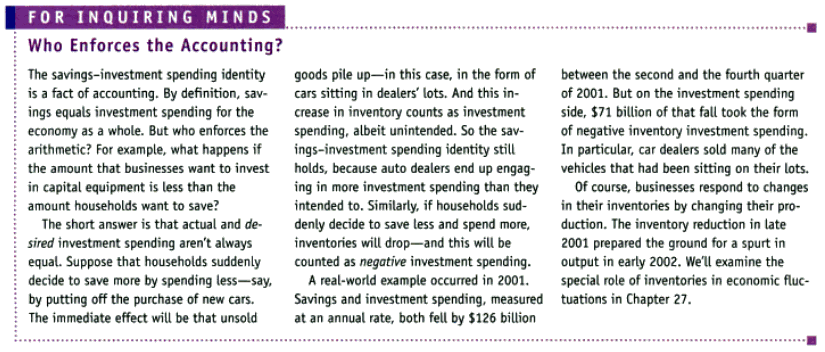Saving Equals … Inventory?
I’ve noticed that many others, like me, are puzzled by the mechanics of the Saving=Investment accounting identity. How do household savings get instantly and perfectly intermediated, in a period, into investment spending — the purchase/creation of long-term productive fixed assets?
An Aha! for me: According to Krugman’s textbook, they don’t.
First a correction: “The savings[sic]-investment identity is a fact of [the] accounting [methods developed in the 30s by Kuznets and company to model production of goods and services the national economy].”
But that aside.
If people spend less than producers expect in a given year, the producers create too much product, and it builds up their inventories. That’s easy to understand. (It’s easier if you think about the producers instead of the car-dealer intermediaries that Krugman talks about.)
In the NIPA model, that inventory is counted as “investment.” This makes sense as far as it goes — that inventory is stored real value, stuff that can be consumed/sold for consumption in future periods. As Mankiw explains it in his textbook:

But this explanation also pretty much obliterates the widespread and sloppy notion that increased saving (“not spending”) results in — causes — more productive “fixed investment.” The increased “investment” resulting from increased personal savings is used to expand inventory. The causations/incentives driving fixed investment are utterly other.
This also makes sense: when people are spending less (are “saving” more), does that spur producers to invest more in their businesses — buy/create more fixed assets?
Both recent and immemorial history suggest quite the opposite.
Cross-posted at Asymptosis.


The reason Krugman uses car dealers is that they are independent businesses and the auto companies count a car as sold when it goes to the dealer. So technically, it is the dealers, not the auto producers that accumulate inventories.
Right, which is why I said it’s easier to think about, not necessarily representing the way businesses account for things.
The big deal here is not even that national account categories labeld “savings” and “investments” are not really what most people understand as “savings” and “invesgments”.
The really big deal is the difference between notional (“ex-ante”) demand and offer for savings and investment and the actual (“ex-post”) demand and supply for funds (for savings and investment).
The notional/”ex-ante” demand and offer , and are those that really matter.
The national accounts are just constructed so that actual/”ex-post” demand and offer for savings and investments are by definition the same, but that’s not terribly interesting, and it was done like much of the national accounts for convenience.
Not only because one interesting thing is that the difference between actual demand and offer (of good, services, or funds) happens in “inventories” as you say, but because there is a much more interesting thing which is the difference between notional and actual savings and investments.
Where “interesting” means principally the effect on subsequent events.
But the distinction between notional and actual demand and offer is wished away by several tricks in standard Economics, principally “tatonnement” or variants within the now, and rational expectations across time, because once you look into that the distribution of income becomes path dependent and in any case no longer unique and pareto optimal.